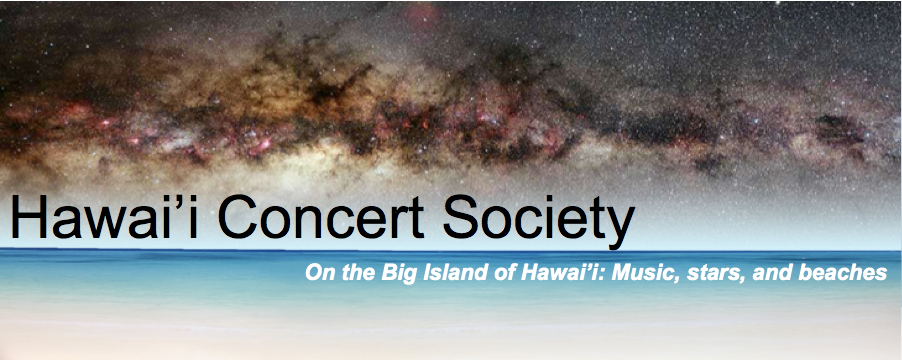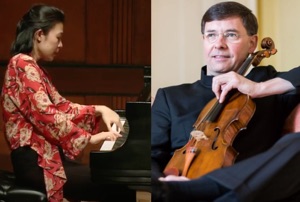Program Notes:
Fauré, Sicilienne and Nocturne No. 6:
In 1892 the manager of the Grand Théâtre, Paris, asked the composer Camille Saint-Saëns to write incidental music for a production of Molière's Le Bourgeois Gentilhomme. Saint-Saëns was too busy to accept the commission, and successfully recommended his friend and former pupil Fauré. The music, which included the first version of the Sicilienne, was nearly complete when the theatre went bankrupt in 1893. The production was abandoned and the music remained unperformed. Five years later, Fauré arranged the work for cello and piano. At the same time, Fauré was working on incidental music for the first English production of Maurice Maeterlinck's play, Pelléas et Mélisande, which opened in June 1898. Needing a lighthearted piece for one of the few playful scenes in the drama, he included the Sicilienne along with the new music he wrote for the production. His former pupil Charles Koechlin orchestrated the score for the theatre orchestra of 16 players. The popularity of the piece has resulted in it being arranged for many groups of instruments, including duos, and as a solo.
A Sicilienne (in Italian Siciliano) is an Italian dance, usually in a minor key, in the meter of 6/8, which uses the distinctive rhythmic figure dotted eighth, sixteenth, eighth. This rhythm occurs in many other pieces in 6/8 (for example Greensleeves).
Fauré composed 13 short piano pieces which he named Nocturnes. Despite the title – which places them in the tradition of Frédéric Chopin – Fauré’s compositions have a style all of their own. They are not dreamy scenes of the night, but carefully structured, iridescent pieces that alternate between lyrical elegance and passionate drama. Fauré composed the 6th Nocturne in 1894, while spending the summer at the house of his parents-in-law, following a ten year break in composing for the piano, during which time both of his parents died and he wrote his famous Requiem. With its strong contrasts of tempo, meter and harmony, it is by far the most significant and best-known of his Nocturnes.
Ludwig, Five Bagatelles:
David Serkin Ludwig is an American composer. His uncle is pianist Peter Serkin and his grandfather was the pianist Rudolf Serkin. Ludwig attended Oberlin College, originally intending to take a degree in art history, but eventually graduating with a degree in music. He then studied at the University of Vienna, Manhattan School of Music (where he obtained a Master’s degree), Curtis Institute of Music, and the University of Pennsylvania (PhD). David Serkin Ludwig is a winner of numerous awards and has written music for many musicians, ensembles, and orchestras. His choral work, The New Colossus, was performed at the 2013 presidential inauguration of Barack Obama. After twenty years on the faculty of the Curtis Institute culminating as Artistic Advisor to the President and Chair of Composition, Ludwig was appointed Dean and Director of The Juilliard School Music Division in May of 2021.
Brahms, Sonata for Viola and Piano in Eb Major:
In 1890 Brahms was entering his late 50s and felt that his composing days were coming to an end. Ever self-critical, he intended to complete a few unfinished works and burn the rest. On a visit to Meiningen in March 1891, however, Brahms heard the orchestra’s principal clarinetist, Richard Mühlfeld, play one of the Weber clarinet concertos and was deeply impressed. For the next several years he composed a number of chamber music pieces for Mühlfeld (who had become a good friend and to whom he began to refer as “Fräulein Klarinette”). In 1894 Brahms wrote for him two sonatas for clarinet and piano.
Brahms also loved the rich, warm sound of the viola, and feeling that the sonatas’ glowing, reflective character would be equally well-served by the rich-toned string instrument, created viola alternatives for the clarinet trios (as he had earlier for the Horn Trio, Op. 40). Within days of sending the clarinet sonatas to his publisher, Brahms sent in alternative parts for viola. They were published simultaneously in June 1895. In the viola versions many aspects of the sonatas are modified, sometimes transposed down an octave, to take advantage of the viola’s low C-string, and sometimes extending phrases a few notes beyond the clarinet part.
As Brahms grew older, his music became texturally simpler and more graceful, reflective, and relaxed. “Autumnal” is the term invariably applied to his late works, and that adjective perfectly describes the atmosphere of the sonata in E-flat major for viola. Brahms’ two viola sonatas are masterworks of this late style: the perfect handling of the sonata form sets the structure for reminiscenses and melancholic introspections, alternated by either passionate or tender interludes. The opening Allegro amabile is moderately paced, with flowing lyrical lines and a sense of warmth. Instead of the traditional slow second movement, Brahms’ second movement is a scherzo in the key of E flat minor, that begins with a fiery viola solo. A reassuring, chorale-like middle section (trio) starts with the piano alone in music of sustained nobility and confidence. The trio is followed by a short transition, heralding a return to the urgency and passion of the first section. The final movement is in the form of a theme and variations, based on a with a flowing, folk-like melody. The final two movements are Brahms’ last compositions in these forms.
Schumann, Piano Sonata f minor:
In the summer of 1836 Robert Schumann was pining for his new love, the sixteen-year-old piano prodigy Clara Wieck, whom he had met three years earlier. Her father Friedrich Wieck (Schumann’s piano teacher) had just arranged a concert tour for her, aiming to break up the romance and avoid acquiring a son-in-law he considered too emotionally volatile and psychologically unstable. Schumann, of course, was not easily discouraged, and contrived to have his beloved with him, at least in spirit, by embedding her into his Sonata in F minor. The sonata was dedicated to the pianist and composer Ignaz Moscheles, to whom in a letter he comments "what crazy inspirations one can have.” In 1853 Schumann revised the work and turned it into a five-movement “sonata.” adding two Scherzos as second and third movements (not performed here). The original second movement is the famous “Variations on a Theme of Clara Wieck,” later to become a favorite encore piece of Vladimir Horowitz. The theme is a twelve-measure melody entitled Andantino that Clara Wieck wrote before she met Schumann.
In the other movements Clara is represented by a five-note descending scale figure derived from the opening of Clara’s theme. In fact the very first music we hear is a powerful statement in the bass, of this idea. It sets in motion a dramatic flourish that crashes to a halt on a C major chord. The halt almost seems like the pianist’s last chance to draw breath before plunging into the impassioned music of this brilliant Allegro.
Next are the Quasi variazioni. There are four variations, the last of which transitions into an extended coda. The theme, as Schumann gives it to us, is solemn, thanks in part to the funeral march rhythm in the bass. And most curiously, it does not end, but gives way to a rising lyric melody, which ends after just eight measures. The first variation also comes to a halt in a similar fashion, and only the Variation 2, with its flowing triplets, arrives at a full close. Variation 3 is full of jumping bass notes and syncopation in the right hand. The final variation returns toward, if not actually to the language and mood of the first movement.
The Finale is sixteen pages of excited and exciting music, full of cross-rhythms and metrical eccentricities, to be delivered passionato, beginning prestissimo possible, a tempo direction that is twice followed by an exhortation to go still faster, resulting in a thrilling and an unforgettable ride.
(Program notes compiled by Tom Geballe)
About the Artists:
A “jaw-dropping pianist who steals the show…with effortless finesse” (Washington Post), Amy Yang balances an active career as soloist, chamber musician and pedagogue. Winner of the 2018 Musical Fund Society of Philadelphia prize and the Kosciuszko National Chopin Piano Competition, she is an alumna of Curtis Institute of Music, Juilliard School and Yale School of Music, where she received the Parisot Award for Outstanding Pianist and the Alumni Association Prize. Ms. Yang is a member of the chamber music faculty at Curtis Institute of Music, where she previously held the roles of program director and piano faculty of Curtis Summerfest’s Young Artist Summer Program. She also teaches at the University of Pennsylvania. She has given masterclasses at UCLA, Mannes College of Music, University of Oklahoma, and for New York Youth Symphony, and her students have soloed with the Philadelphia Orchestra and entered top conservatories. For more information visit https://www.amyjyang.com.
Chilean-American violist Roberto Díaz has a long and distinguished career as performer and educator. He has been President and CEO of the Curtis Institute of Music since 2006. Prior to his appointment at Curtis, he was principal violist of the Philadelphia Orchestra, where he performed the entire standard viola concerto repertoire and presented a number of Philadelphia Orchestra premieres. In demand as a soloist, he collaborates with leading conductors of our time, and has appeared with the symphony orchestras of Minnesota, Boston (at Tanglewood), Nashville, New World, Aspen, Grant Park, and Calgary, among others. He has also worked directly with important 20th- and 21st-century composers, including Krzysztof Penderecki, Edison Denisov, Roberto Sierra, and Jennifer Higdon. As a chamber musician, he has toured Europe, Asia, and the Americas as a member of the Díaz Trio with violinist Andrés Cárdenes and cellist Andrés Díaz (his brother). Among Mr. Díaz's numerous recordings are the complete works for viola and piano by Henri Vieuxtemps, a Grammy-nominated disc of viola transcriptions by William Primrose, and the Brahms sonatas with Jeremy Denk. Mr. Díaz plays the ex-Primrose Amati viola. For more information see https://www.curtis.edu/academics/faculty/roberto-diaz/.


